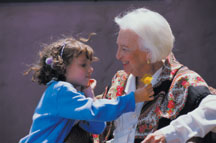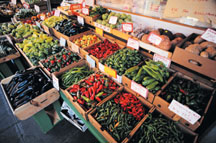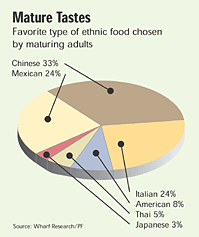
In 15 years, nearly 21 million Americans are expected to be over the age of 75. That is 4 million more than now, and the proportion of those over the age of 85 is growing the fastest. The consequences of this trend cannot be ignored, as the progressive “graying of America” will have important implications on spending and food demand. Expect more products to focus on the elderly demographic, targeting their needs and wants.
As it stands now, this group represents a large but uncultivated demographic. The Global New Products Database (GNPD), Chicago, identifies only 10 products introduced in the last two years as targeting seniors (aged 55+). Six were egg, meat and poultry products irradiated to kill foodborne illness-causing bacteria, such as Salmonella and E. coli.
While many question the strategy of labeling consumers as “senior,” there are numerous opportunities and advantages to be had in reaching this group. One approach, for example, would be to involve seniors' organizations as partners and sources of market information.
The needs of this consumer segment are different. For example, seniors often require products with a heightened nutrition profile, that are convenient and packaged in smaller servings. The items must not only meet the needs of smaller households but also be easy to open and prepare. One approach targeting this group overlaps efforts to reach wellness-conscious mainstream adults, those who are concerned with their healthiness now and in the future.
Health Issues
Most seniors today face a variety of health concerns, says the National Institution of Nutrition, Ottawa, Ontario, Canada. This group reports 80-85% of North American seniors have dental problems or medical conditions (including osteoporosis, arthritis, heart disease, digestive disorders, diabetes, hypertension and cancer) that impact their diets.An increasing number of sophisticated consumers (particularly those included among the baby boomer generation) are aware of the importance of adequate nutrition—in conjunction with other aspects of a healthful lifestyle—in negating or offsetting the degenerative biological changes associated with aging. Older adults are very interested in tasty “nutrition value added” products as a component of a healthful lifestyle, and the appeal of these products will increase as this population becomes increasingly educated and more health-conscious.
A 1994 study in Agribusiness related the significant impact of age on spending. Results indicated that Americans 65 and older tended to spend more on food at home (and less on food away-from-home) than younger Americans. Food-at-home expenditures were highest among the 65- to 74-year-old group.
Research by the National Institution of Nutrition, found that almost 60% of North American seniors are women, and the gender gap widens as age advances. More than 90% of all seniors still live in the community (as opposed to institutionalized care), and about 60% of this group currently has less than a high school education. This percent will decrease as the better-educated baby boomer generation enters its golden years.
Likewise, annual incomes of seniors also will see improvement from current levels. In the U.S., 42% of elderly women and 17% of men have annual incomes of less than $6,000. Due to a decrease in the need for food and a reduction in the number of times they eat out, those over the age of 65 generally spend less on food compared with the rest of the population.
Attracting these consumers will require a focused effort, one that emphasizes taste and convenience. Additional nutritional value will, of course, be an important element, including lower fat and sodium, higher fiber and calcium, and perhaps in the future, nutraceutical elements. To communicate those advantages, packaging labels should be easy to read and understand, with useful nutritional information clearly identified.

Furthermore, smaller-size packages benefit those who “graze” throughout the day. The Report on Maturing Adults in America, a national study conducted by Wharf Research at the Center for Culinary Development, San Francisco, discovered seniors are more likely to graze during the day than to eat regular meals. Only 34% ate three full meals per day, while nine in 10 (91%) maturing adults said they grazed at least once a day. Of the total, 63% said they graze two or more times a day.

Nutritional Intake Importance
While a complete understanding of the nutritional needs of seniors has yet to be quantified, studies have found age brings a marked decrease in energy intake. As the elderly eat less, they often fail to consume the recommended amounts of vitamins and minerals. A survey in Quebec reported by the National Institute of Nutrition found the energy intake of the province's women aged 65-74 was below 1,500 kcal/day, and 25% were consuming less than half of the recommended intake for calcium.Poor nutrition results in a reduced resistance to infection and slowed healing, and seniors have special food needs as they age, particularly those with medical conditions and compromised mobility. They require foods with high levels of protein, vitamins, minerals and—possibly—calories in smaller volumes. This increase in nutrient density may well result from ingredient selection, fortification or by using nutritional supplements.
One recent product launch demonstrates the fortification for seniors concept. Paradise Pops, Bronx, N.Y., introduced Frozen Treats, a lowfat frozen fruit cup fortified with 15g of whey protein, targeted to retirement centers and nursing homes.
The National Institute of Nutrition found, however, that the industry is not focused on seniors to a great degree. In fact, “two thirds of industry respondents reported poor R&D investment in the seniors market. The lack of corporate priority, regulatory issues around fortification, health claims and the promotion of foods 'for special dietary use' to consumers, as well as assembling enough 'critical mass' were key barriers to market. In the institutional market, price was often seen as prohibitive, given the price ceiling in long-term care.”
Marketing to the Mature
Reaching those elderly consumers may require a different slant/tactic than that employed to reach other demographic groups. The Report onMaturing Adults in Americafound seniors were best targeted by age and gender, with education and income having far less impact.As far as their taste preferences, Wharf Research noted that the palates of America's seniors are mirroring those of their youthful counterparts, enjoying ethnic foods such as Chinese, Mexican and Italian. In addition, respondents had a high awareness and trial of emerging global tastes, such as quesadillas, sushi and pesto.
Men were most likely to choose taste over nutrition, the report said, echoing the widely held sentiment that flavor is an important consideration in food for the elderly adult, often a victim of a decline in taste and smell sensations. The National Institute of Nutrition estimates that flavors need to be two to 12 times higher than for younger adults.
Prepare for the Boom
Companies are well-advised to initiate efforts to meet the needs of the elderly population—if not for the modern mature, then for those who are rapidly approaching their senior years. While the current generation of seniors possesses considerable spending power as a whole, that amount will rise significantly as America's largest generation begins to hit retirement age. The baby boomer generation numbers more than 75 million. Members of this generation are 38 to 57 years of age and, although they recognize many of the health issues of aging, most admit they are taking few (if any) steps to maintain good health.Such are the findings of “A New Age of Aging-A Study of Baby Boomer Behaviors on Growing Older,” a study conducted by the Alliance for Aging Research, Washington D.C. Results showed that these consumers are uneasy about aging because they fear a loss of attractiveness and contracting a debilitating disease.
However, these concerns are not great enough to warrant major changes in eating and lifestyle habits. While some modest changes can be found, many of these are maintained only for a short term. Some 86% of boomers say they have made dietary changes within the past year. Of these, 51% report they should be eating more healthful food but are not. Reasons include a lack of discipline (17% of respondents), a lack of time to eat healthfully (12%) and some who contend they are too young to worry about eating healthfully (3%).
The most popular dietary changes include a move to more healthful food, i.e., fruits and vegetables, as well as foods with fiber, such as oatmeal and whole grain bread. Some 57% say they have taken vitamins, minerals and dietary supplements to look and/or feel younger.
“Given the incidence of obesity, high blood pressure and other health-related problems among boomers, this generation knows they should be doing more,” says Daniel Perry, executive director of the Alliance. “Unfortunately for many boomers, they are about to have a close encounter of the most serious kind with diseases associated with aging. Mentally and physically, they are not ready.”
